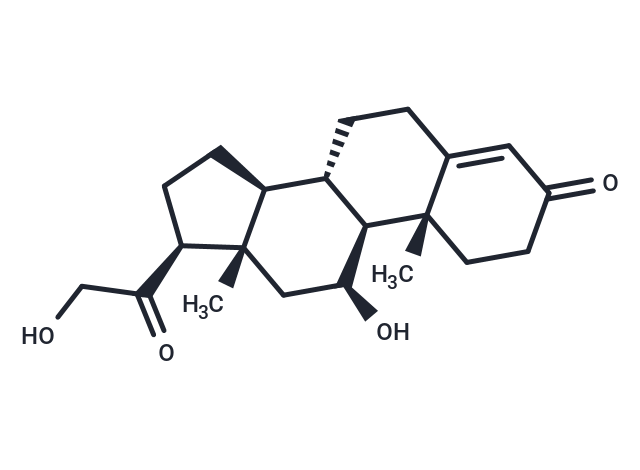Shopping Cart
- Remove All
 Your shopping cart is currently empty
Your shopping cart is currently empty

Corticosterone (Kendall's compound B) is an adrenocortical steroid with salocorticoid and glucocorticoid activity that is orally active. Corticosterone is involved in the regulation of energy, immune responses, and stress responses in the body.

| Pack Size | Price | Availability | Quantity |
|---|---|---|---|
| 50 mg | $41 | In Stock | |
| 100 mg | $57 | In Stock | |
| 200 mg | $83 | In Stock | |
| 1 mL x 10 mM (in DMSO) | $45 | In Stock |
| Description | Corticosterone (Kendall's compound B) is an adrenocortical steroid with salocorticoid and glucocorticoid activity that is orally active. Corticosterone is involved in the regulation of energy, immune responses, and stress responses in the body. |
| In vitro | METHODS: The mouse mammary hyperplastic epithelial cell line TM10 was treated with Corticosterone (50-200 µM) for 24-72 h. The cell number was detected by crystal violet staining. RESULTS: Corticosterone significantly inhibited cell growth by 50, 57, and 76% after treatment with 50, 100, and 200 µM for 72 hours. [1] METHODS: Human neuroblastoma cells SK-N-BE(2)C were treated with Corticosterone (1-100 nM) for 1-14 days, and gene expression levels were measured by RT-PCR. RESULTS: Corticosterone increased NET mRNA levels in SK-N-BE(2)C cells. [2] |
| In vivo | METHODS: To investigate the effects on depressive-like behavior in mice, corticosterone (20 mg/kg, suspended in physiological saline containing 0.1% DMSO and 0.1% Tween-80) was injected subcutaneously into C57BL/6N mice once daily for 1-5 weeks. RESULTS: Repeated injections of corticosterone increased immobility behavior in a time-dependent manner in the forced swimming and tail suspension tests. At the same time, this injection pattern had a time-dependent effect on tyrosine hydroxylase levels in the mouse hippocampus. These RESULTS are consistent with correlations in models of stress-induced depression. [3] METHODS: To investigate the modulatory effects on fear, Corticosterone (2 mg/kg, 2.5% EtOH in saline) was injected intraperitoneally into C57Bl/6 mice trained in an auditory fear conditioned reflex paradigm. RESULTS: Corticosterone affected memory consolidation and recovery; in male mice, corticosterone consistently increased freezing behavior to tones, whereas in female mice, corticosterone reduced freezing behavior 24 h after training. [4] |
| Cell Research | HEK293 cells are grown in 6-cm dishes in 10% fetal bovine serum DMEM medium. When cells are 90% confluent, the medium is changed to 0.5% fetal bovine serum DMEM to limit serum-induced up-regulation of SGK. For in vitro phosphorylation analysis, the following approach is used. HEK293 cells are transfected with or without SGK1 small interfering RNA. One day after transfection, cells are treated without or with 100 nM corticosterone for 30 min, washed, and maintained in 0.5% fetal bovine serum DMEM for 1.5 h. Then cells are lysed in the CytoBuster protein extraction reagent containing protease inhibitors. Cell lysates are centrifuged at 16,000 × g at 4 °C for 20 min. The supernatants (40 μl, ~50 μg of total protein) are incubated with 1 μg of purified GST fusion protein of wild-type GDI or its mutants for 30 min at 30 °C in the reaction buffer (30 mM HEPES, pH 7.5, 10 mM MgCl2, 30 μM ATP, 1 μCi of [γ-32P]ATP, 100 nM calyculin, 1 μM okadaic acid). SDS-PAGE is carried out, and phosphorylated GDI is visualized with autoradiography.(Only for Reference) |
| Alias | Kendall's compound B, Corticosterone (From plants), 17-Deoxycortisol, 11β,21-Dihydroxyprogesterone |
| Molecular Weight | 346.46 |
| Formula | C21H30O4 |
| Cas No. | 50-22-6 |
| Smiles | C[C@]12C[C@H](O)[C@H]3[C@@H](CCC4=CC(=O)CC[C@]34C)[C@@H]1CC[C@@H]2C(=O)CO |
| Relative Density. | 1.0413 g/cm3 (Estimated) |
| Storage | Powder: -20°C for 3 years | In solvent: -80°C for 1 year | Shipping with blue ice. |
| Solubility Information | H2O: insoluble 10% DMSO+40% PEG300+5% Tween 80+45% Saline: 3.47 mg/mL (10.02 mM), In vivo: Please add the solvents sequentially, clarifying the solution as much as possible before adding the next one. Dissolve by heating and/or sonication if necessary. Working solution is recommended to be prepared and used immediately. Ethanol: 3.5 mg/mL (10.1 mM), Sonication is recommended. DMSO: 45 mg/mL (129.89 mM), Sonication is recommended. |
Solution Preparation Table | |

Copyright © 2015-2025 TargetMol Chemicals Inc. All Rights Reserved.